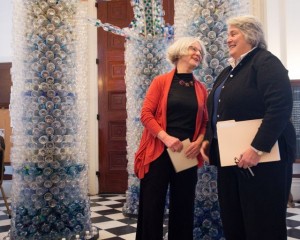
It loomed large and took up a good part of the lobby of the Statehouse, rising 10 feet high. But then “Inherently Unstable,” built of empty plastic water bottles, PVC, cardboard, chicken wire and related detritus by long-time “junk” artist Beth Haggart and students from the University of Vermont, is meant to make a statement.
Unlike carbonated beverages, which come in 5-cent deposit bottles, these bottles are not recyclable or returnable. With a university population of 14,000, the total water bottles going to landfills — or blowing around the campus — was over a million a year before the recent ban on the bottles, according to UVM’s director of sustainability, Gioia Thompson. Students can now refill water bottles at campus drinking fountains converted to filling stations for reusable bottles.
The arch, which glowed in the cool winter light on a snowy day in Montpelier, migrated to the Statehouse from the University of Vermont, where it was built to herald the arrival of the bottled-water ban that began officially on Jan. 1. It has its place in the Statehouse, too, because last year the state’s Agency of Natural Resources banned all single-serve water bottles in public buildings. The Statehouse cafeteria now sells only reusable water bottles.
The three-legged art installation in the Statehouse was a revised version of the two-legged arch at the university, which did not have to stand on its own two legs because it was hung in the atrium of UVM’s Davis Center. Haggart says that even by the time of its creation last fall, it was not an easy task to find the 2,000 bottles needed, because students, faculty and staff had been using refillable water bottles for some time. To add the third leg for the new piece meant the hard work of scrounging for another 1,000 bottles, she says with a smile.
At a press conference on Wednesday, Sen. Ginny Lyons, D-Chittenden, introduced Haggart, saying the focus was on celebrating “art that encourages us to reflect and gives us the opportunity to look at who we are and at the products we use and to make our own decisions about how we use them.”

Bans on non-recyclable plastic bottles, said Sen. Dick McCormack, D-Windsor, when he came to the podium, emphasize the importance of the word “Reduce” in the maxim of “Reduce, Reuse and Recycle.” Besides, he added, there’s nothing wrong with tap water from a well-managed municipal water supply. One argument made for water bottle bans is that municipal systems are held to higher standards than those for bottled-water manufacturers. Another, displayed on the fact sheet next to the bottle arch, points out that nearly 50 percent of the time consumers, who are paying billions for bottled water, are in fact getting tap water. Bottled water, based on figures from 2009, costs about 1,000 times what water straight from the tap does.
Establishing the bottled-water ban hinged on not renewing a 10-year corporate sponsorship contract with Coca-Cola. That contract ran out in July of last year, opening the way for the ban to take effect.
Mikayla McDonald is a UVM graduate who as a student co-chaired the revolt against the corporate sponsorship contract, which made bottled water and soft drinks available on campus but also brought the university $430,000 in shared sales. She advocates a broader ban on bottled water.
McDonald would invest the savings in maintaining municipal water systems and, looking at the larger picture, she laments “commodifying and privatizing a limited natural resource critical to life” as corporations buy up water rights and then “sell them back to people, making a natural resource too expensive for many around the world.”
Is there pushback? Not any more, according to McDonald and Thompson. Environmental “goods” are no longer seen as anti-business, requiring a choice of one or the other. Sen. Lyons alluded to the “benefits to business” of a shift to environmentally beneficial policies, citing Casella Waste Management as an example. Casella, one of the state’s major waste haulers and recyclers, was present at the press conference, too. For the company. increasing recyclable trash and reducing the non-recyclables that must go into landfill are good for business.
The debut of the art piece at the Statehouse reflects more than student activism. Vermont itself is moving toward “universal recycling of solid waste” as a complement to removing non-recyclables from the waste stream. Last year, with Act 148, the Legislature passed a statewide solid-waste management plan to be completed by Nov. 1 this year.
Act 148 covers a multitude of “sins,” everything from garbage, septage and sludge from waste-treatment and water-supply plants or pollution control facilities to waste from industrial, commercial, mining or agricultural operations and from community activities. It also covers the “source-separated” mandated recyclables — aluminum and steel cans; aluminum foil and aluminum pie plates; glass bottles and jars from foods and beverages; polyethylene terephthalate (PET) plastic bottles or jugs; high density polyethylene (HDPE) plastic bottles and jugs; corrugated cardboard; white and colored paper; newspaper; magazines; catalogs; paper mail and envelopes; boxboard; and paper bags.
The following is a list of facts about UVM drink consumption from Gioia Thompson:
Bottled water purchases totaled more than 360,000 in 2007, before the student campaign, and had dropped to 235,000 in 2010.
Between 2007-2010 soft drinks dropped from 387,000 to 316,000. People drank more tea: from 14,000 to 113,000.
The total amount sold in 2010 was 1.1 million beverages of all kinds under the corporate sponsorship arrangement with Coca Cola of Northern New England.
The mix of bottled drinks: water 21 percent; soda 29 percent, juices 17 percent, tea 10 percent, other 23 percent.
Editor’s note: This story was updated with UVM facts from Thompson at 11:28 a.m. on March 24.
